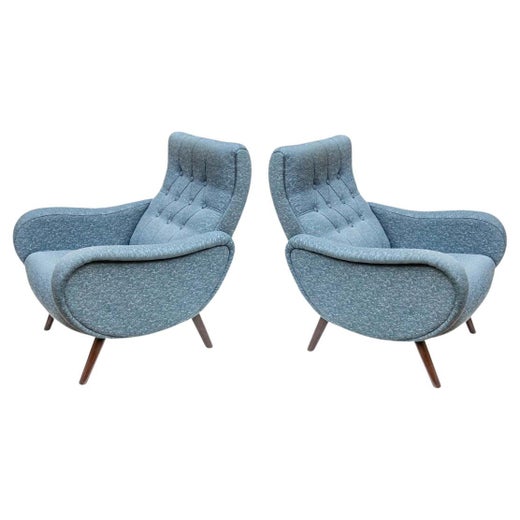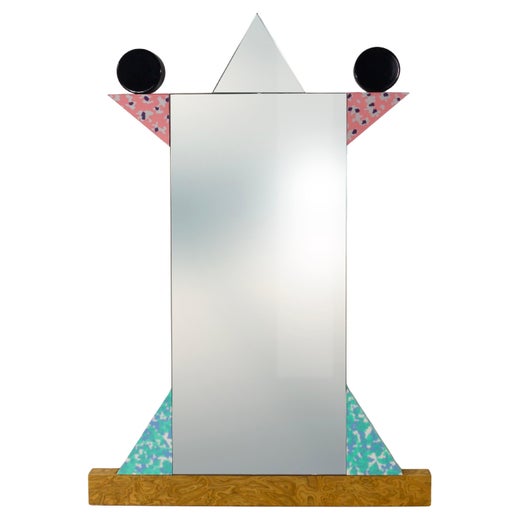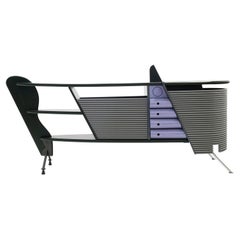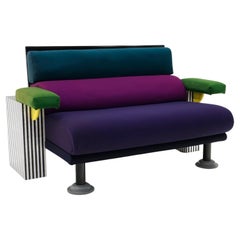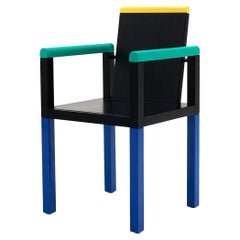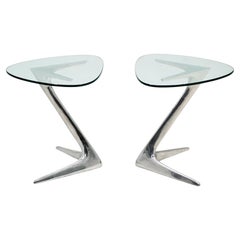Marco Zanuso Cleopatra Occasional Table for Memphis, Milano, 1987, Signed
About the Item
- Creator:Marco Zanuso (Designer),Memphis Group (Manufacturer)
- Dimensions:Height: 28.75 in (73.03 cm)Diameter: 13.5 in (34.29 cm)
- Style:Post-Modern (Of the Period)
- Place of Origin:
- Period:1980-1989
- Date of Manufacture:1987
- Condition:Few signs of use. A rare and excellent example of this design.
- Seller Location:Kansas City, MO
- Reference Number:1stDibs: LU105708356073
Marco Zanuso
Italian designer Marco Zanuso helped cement his country’s place as a world leader in furniture design that used new materials in revolutionary ways.
Zanuso was part of a generation of furniture designers who encouraged a sharp departure from the traditionalism and classicalism that reigned over the design industry before the war. These designers, who are associated with what we now call mid-century modernism, experimented with new technologies and materials to deliver on the world’s newfound need for streamlined products that represented the future.
After graduating from the Polytechnic University of Milan in 1939 with a degree in architecture, Zanuso served in the Navy during World War II. Soon after the war, he opened his own design firm in Milan in 1945. He later became an editor at well-regarded design magazines Domus and Casabella.
Zanuso used this editorial platform to both promote new Italian designs as well as his own pieces, some of which he made using unconventional materials like foam and latex. For instance, his famous Lady armchair from 1951 is a composition of foam rubber and Nastro Cord, a recently invented textile band of rubberized fabric that eliminated the need for metal springs. It was one of several pieces he designed for Italian manufacturer Arflex, along with the 1949 Antropus chair and the 1951 Sleep-o-matic sofa.
Zanuso often collaborated with other like-minded creatives. From 1955 until 1957, he was Olivetti’s architect, designing factories across Brazil, and for nearly two decades, he collaborated with German designer Richard Sapper. The pair’s most famous product is the 4999 children’s chair, manufactured in the 1960s by Kartell in Italy. The stackable chair was the first to be manufactured entirely of injection-molded plastic.
Zanuso and Sapper also partnered on the 1962 Brionvega Doney 14, the first European-made portable transistor TV; its sleek, compact and curvy form deeply influenced the design of television sets that followed, which were far more sculptural in form than the rigid boxes that characterized early models.
From the 1970s onward, Zanuso taught architecture and industrial design at the Polytechnic University of Milan. He still exercised his creative talents, planning the headquarters for computer companies and renovating Italian theaters.
Each of Zanuso’s elegant works were demonstrative of a forward-looking sensibility. His projects saw an integration of novel industrial materials that not only helped emphasize the beauty of good design but also played a role in rendering these well-made products accessible to everyday consumers.
On 1stDibs, find a collection of vintage Marco Zanuso furniture, including armchairs, sofas, table lamps and other items.
Memphis Group
To many people, postmodern design is synonymous with the Memphis Group. This Italian collaborative created the most radical and attention-getting designs of the period, upending most of the accepted standards of how furniture should look.
The Memphis story begins in 1980, when Ettore Sottsass, then a beacon of Italian postmodernism, tapped a coterie of younger designers to develop a collection for the Milan Furniture Fair the next year, determined that all the new furniture they were then seeing was boring. Their mission: Boldly reject the stark minimalism of the 1970s and shatter the rules of form and function. (Sottsass’s Ultrafragola mirror, designed in 1970, embodied many of what would become the collective’s postmodern ideals.)
The group decided to design, produce and market their own collection, one that wouldn’t be restricted by concerns like functionality and so-called good taste. Its debut, at Milan’s 1981 Salone del Mobile, drew thousands of viewers and caused a major stir in design circles.
So as a record of Bob Dylan’s “Stuck Inside of Mobile” played on repeat, they took their name from the song, devised their marketing strategy and plotted the postmodern look that would come to define the decade of excess — primary colors, blown-up proportions, playful nods to Art Deco and Pop art. A high-low mix of materials also helped define Memphis, as evidenced by Javier Mariscal’s pastel serving trays, which feature laminate veneer — a material previously used only in kitchens — as well as Shiro Kuramata’s Nara and Kyoto tables made from colored glass-infused terrazzo.
An image of Sottsass posing with his collaborators in a conversation pit shaped like a boxing ring appeared in magazines all over the world, and Karl Lagerfield furnished his Monte Carlo penthouse entirely in Memphis furniture. Meanwhile, members like Andrea Branzi, Aldo Cibic, Michele de Lucchi, Nathalie du Pasquier, Kuramata, Paola Navone, Peter Shire, George Sowden, Sottsass and his wife, journalist Barbara Radice, went on to enjoy fruitful careers.
Some people think of the Milan-based collective as the design equivalent to Patrick Nagel’s kitschy screenprints, but for others Memphis represents what made the early 1980s so great: freedom of expression, dizzying patterns and off-the-wall colors.
Eventually, the Reagan era gave way to cool 1990s minimalism, and Memphis fell out of fashion. Sottsass left the group in 1985, and by 1987, it had disbanded. Yet decades later, Memphis is back and can be traced to today’s most exciting designers.
“As someone who was born in the 1980s, Memphis at times feels like the grown-up, artsy version of the toys I used to play with,” says Shaun Kasperbauer, cofounder of the Brooklyn studio Souda. “It feels a little nostalgic, but at the same time it seems like an aesthetic that’s perfectly suited to an internet age — loud, colorful and utilizing forms that are graphic and often a little unexpected.”
Find a collection of vintage Memphis Group seating, tables, decorative objects and other furniture on 1stDibs.
You May Also Like
Vintage 1960s Italian Space Age Side Tables
Metal
21st Century and Contemporary Italian Modern Side Tables
Wood
21st Century and Contemporary Italian Modern Side Tables
Glass, Plastic
Vintage 1980s Japanese Post-Modern Side Tables
Metal, Chrome
21st Century and Contemporary Italian Modern Side Tables
Wood, Plastic
21st Century and Contemporary Italian Modern Side Tables
Wood, Plastic
21st Century and Contemporary Italian Modern Side Tables
Wood, Plastic
21st Century and Contemporary Italian Modern End Tables
Wood, Plastic
Vintage 1980s American Post-Modern Side Tables
Metal
21st Century and Contemporary Italian Modern Tables
Metal
More From This Seller
View AllVintage 1980s Italian Post-Modern Dry Bars
Steel, Chrome
Vintage 1980s Italian Post-Modern Loveseats
Metal
Vintage 1980s Italian Post-Modern Armchairs
Wood
1990s American Mid-Century Modern Side Tables
Aluminum
Vintage 1980s American Post-Modern Lounge Chairs
Upholstery, Laminate, Wood
Vintage 1950s American Mid-Century Modern Side Tables
Ceramic, Mahogany
